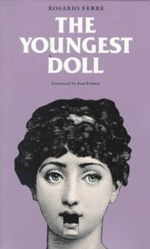
Dr. Rosario Ferré is well known in her native Puerto Rico as a writer, poet, essayist, teacher and scholar, not to mention her service as First Lady of the Commonwealth when her father was Governor and her mother passed away during his tenure. Educated both in the US and at home, she has a particularly wide-ranging voice and vision.
Ferré's stories initially conjure Gabriel Garcia Marquez's classic One Hundred Years of Solitude, but she quickly moves beyond the limits of his magical realism. Her stories are more intentional and more frightening, less a tribute to a rich culture than a comment upon it. And Ferré's characters speak most clearly for women, in sensuous, ironic voices that grow out of oppression and anger.
Compare her work to that of the visual artist Pablo Picasso. He broke the rules of perspective to show us more than one view of a subject simultaneously. Ferré does the same with point of view. She weaves together several voices into a narrative collage that synthesizes the elements of the story, giving it exceptional depth.
For instance in "The Poisoned Story," we are presented with Rosita, who is reading a story about her step-daughter Rosa and herself, presumably written by a local writer. We are offered the story she reads, along with Rosita's reactions and her own version of events—as well as the events going on around her as she bends over the book at the funeral of her husband. By the end, we know what the community thinks of Rosita, what she thinks of herself, what the truth may be, and we also know what will become of Rosita in real time.
Sound confusing? Initially, most of Ferré's stories require some quick work on the part of the reader. I often returned to reread the first page or two once I had sorted out the voices. But that bit of extra work is well worth the effort. The first two-thirds of the book offers an impressive array of stories, displaying a broad view of Puerto Rican society: the poor and the rich, the outcasts and the powerful, along with strangely horrific details. Life-sized dolls filled with honey, crayfish that live under the skin, a beautiful dust-garden in the shadow of a cement factory, dreams that take over lives, houses that vanish, and vengeance through poison. And those are only the warm-up rounds; the last few pieces in the book raise her work into the literary stratosphere.
"Sleeping Beauty" tells of a young woman whose passion is to dance ballet. Events are related through letters between her father, an aristocratic patriarch, and her Catholic school principal, excerpts from the society column in the local newspaper, and letters written by and to her husband. All of this is interspersed with the young woman's stream-of-consciousness impressions, almost musical in nature, which bring the many voices together into a kind of tragic dance. The story's theme is one Ferré returns to again and again: a woman whose progress in life is thwarted by her family, her society, her church and the men who make her decisions for her.
Ferré's feminist agenda is further developed through the story "When Women Love Men," in which two women—a black prostitute and a white aristocrat—are brought together by the man they share, who dies and leaves his property to them both. Here we see the author's ability to intertwine two characters (two points of view, two positions in society, two life experiences) through their common experience as women. The voices shift and separate, join and interact until they are one. The effect is stunning.
Finally, two essays by the author testify to her unusual intelligence and the conscious
power she exercises in these stories, which require not only literary dexterity, but
the ability to translate language, culture and gender for the reader. This English
translation of Rosario Ferré's early work (mostly translated by the author herself)
is a gift to the English-language world. Many serious readers, students and scholars will
no doubt find in it a treasure trove of literary excellence, as entertaining as it is
inspiring.

Univ. of Nebraska Press, paperback, 9780803268746
